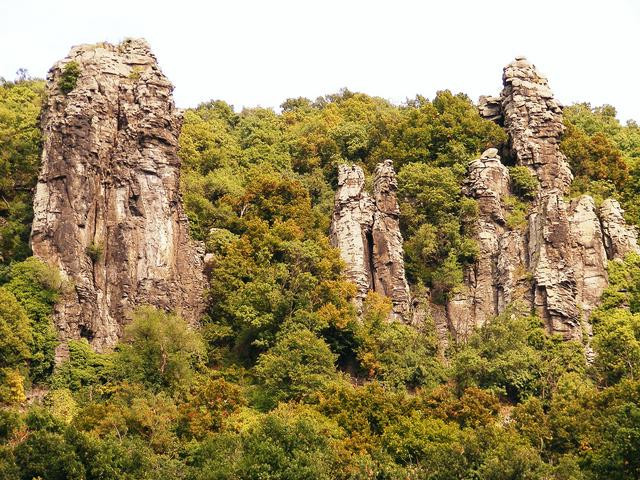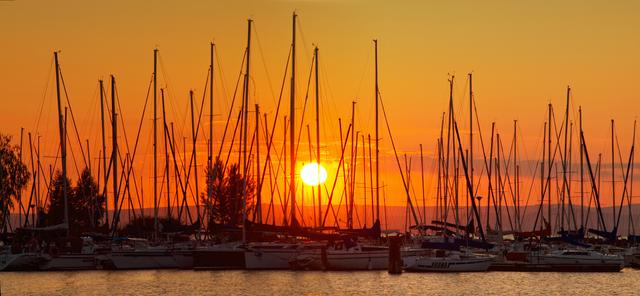Balaton (Plattensee in German) is the biggest lake by surface area in Central Europe and gives its name to this entire Hungarian Lake Balaton region.
- Badacsony. — most famous winehill for its wine, on the northern coast
- Balatonszárszó. - popular, family-friendly tourist destination on the south shore of Lake Balaton
- Balatonszemes.
- Szent György-hegy. — perfect for hiking, visit the basalt organs
- Szigliget. — with the ruins of a Castle on the hilltop
- Tihany. — nice peninsula with an inner lake and church visible from most of the lake
- Balaton Uplands National Park. – located to the north of Lake Balaton
- Exhibition sites: Arboretum Zirc, House of Forests Bakonybél, Lóczy Cave Balatonfüred, Hegyestű Geological Exhibition Site Monoszló, Manor Salföld, Lake Cave of Tapolca, Kotsy Watermill Zalaszántó, Folk House Vörs, Buffalo Reserve Kápolnapuszta, Csodabogyós Cave Balatonederics, Kőlik Cave of Szentgál, Disused Sand Quarry Várpalota
Badacsony. — most famous winehill for its wine, on the northern coast
Balatonszárszó. - popular, family-friendly tourist destination on the south shore of Lake Balaton
Balatonszemes.
Szent György-hegy. — perfect for hiking, visit the basalt organs
Szigliget. — with the ruins of a Castle on the hilltop
Tihany. — nice peninsula with an inner lake and church visible from most of the lake
Balaton Uplands National Park. – located to the north of Lake Balaton
Exhibition sites: Arboretum Zirc, House of Forests Bakonybél, Lóczy Cave Balatonfüred, Hegyestű Geological Exhibition Site Monoszló, Manor Salföld, Lake Cave of Tapolca, Kotsy Watermill Zalaszántó, Folk House Vörs, Buffalo Reserve Kápolnapuszta, Csodabogyós Cave Balatonederics, Kőlik Cave of Szentgál, Disused Sand Quarry Várpalota
The Balaton was popular during the Cold War with both Easterners and Westerners because it was cheap and relatively easy to reach from both sides of the Iron Curtain.

- Badacsony: the most well-known, most popular hill of the region. On this truncated cone of volcanic origin. Viticulture. Hiking routes and a four km long study path
- Balatonederics: Africa Museum and Zoo
- Balatonszentgyörgy: Csillagvár is a star form hunting mansion
- Small-Balaton: A study path on Kányavári Island. Buffalo Reserve in Kápolnapuszta near Zalakomár
- Szent György Hill: Basalt organ pipes nature monument
- Szigliget: Castleruin of Szigliget on top of a 230 m high volcanic hill
- Tapolca: Grotto - Cave Lake with length of four km
 Beautiful national parks, protected quarters, they demonstrated the old times, reservatums, theatres, aquaparks, sea baths, sport opportunities on earth, water and air, concerts and beautiful museums await every visitor.
Beautiful national parks, protected quarters, they demonstrated the old times, reservatums, theatres, aquaparks, sea baths, sport opportunities on earth, water and air, concerts and beautiful museums await every visitor.
- Caving — see Exhibition sites above
- Hiking in the northern hills.
- Exploring wine cellars. A well worn trail is the climb up Badacsony Hill, which is peppered with small wine growers selling their wines by the glass and bottle. Much of it is mediocre but you may find some gems. Treat it like a pub crawl and have fun.
- Cross-Balaton Swim Contest..
- Relaxing in thermal spas. The two best known are at Héviz and Csisztapuszta (just south of Fonyód). Marcali, in northern Somogy county
- Sailing. There are several annual sailing races for those preferring competition. For boat rental Fonyod, Balatonlelle and Balatonfüred are the best places. An 8-m yacht from about Ft 70,000/day.
- Swimming. Summer water temperatures range from about 16 °C to the mid 30s; because the lake is shallow, yesterday's air temperature will be a good guide to the warmth of today's water. There are many places to go down waterslides and just take in a bit of shallow bathing, but be aware that the shallow banks of Balaton are very murky. You can scarcely avoid getting silt everywhere. Beaches on the north shore tend to have more facilities, but have an entrance fee.The shore here tends to be rocky and the water deepens rapidly to a maximum of about 14 m. Most beaches on the southern shore are free, though large sections of the shore are privately owned by hotels and campsites. The lake shelves slowly, so you can walk out for 500 m or more before you are out of your depth, so it's very safe for children. Large free beaches are at Zamárdi, Balatonboglár, Fonyód and Balatonfenyves. There are many hundreds of access points to the shore, so you are unlikely to have to walk far to find a pleasant place to swim.
Since the lake is shallow, summer storms can create very large waves, and people have drowned in most years. A system of warning beacons around the lake alerts bathers to expected strong winds and storms: 30 flashes/minute, colour white/yellow means winds 40-60 km/h, and you should move close to the shore. 60 flashes red/white means winds over 60 km/h. Time to get out quickly!
- Kite surfing. On windy days this is an exciting sport, but it takes a few days to learn to stop falling off. Needs a reasonable level of fitness. Centres are Balatonboglár and Balatonfenyves.
Caving — see Exhibition sites above
Hiking in the northern hills.
Exploring wine cellars. A well worn trail is the climb up Badacsony Hill, which is peppered with small wine growers selling their wines by the glass and bottle. Much of it is mediocre but you may find some gems. Treat it like a pub crawl and have fun.
Cross-Balaton Swim Contest..
Relaxing in thermal spas. The two best known are at [[Héviz]] and Csisztapuszta (just south of Fonyód). [[Marcali]], in northern Somogy county
Sailing. There are several annual sailing races for those preferring competition. For boat rental Fonyod, Balatonlelle and Balatonfüred are the best places. An 8-m yacht from about Ft 70,000/day.
Swimming. Summer water temperatures range from about 16 °C to the mid 30s; because the lake is shallow, yesterday's air temperature will be a good guide to the warmth of today's water. There are many places to go down waterslides and just take in a bit of shallow bathing, but be aware that the shallow banks of Balaton are very murky. You can scarcely avoid getting silt everywhere. Beaches on the north shore tend to have more facilities, but have an entrance fee.The shore here tends to be rocky and the water deepens rapidly to a maximum of about 14 m. Most beaches on the southern shore are free, though large sections of the shore are privately owned by hotels and campsites. The lake shelves slowly, so you can walk out for 500 m or more before you are out of your depth, so it's very safe for children. Large free beaches are at Zamárdi, Balatonboglár, Fonyód and Balatonfenyves. There are many hundreds of access points to the shore, so you are unlikely to have to walk far to find a pleasant place to swim.
Kite surfing. On windy days this is an exciting sport, but it takes a few days to learn to stop falling off. Needs a reasonable level of fitness. Centres are Balatonboglár and Balatonfenyves.
Buy local wine of course!
The land of Balaton delights not just your eye, but your stomach. On every area receive you a real gastronomical history. You can taste the traditional foods of lands, or the famous wines of the land of Balaton.
One kind of local food is lángos, a bread-like pastry usually sold on beaches. It is offered with different toppings like cheese, sour cream, and ham, or often plain just with garlic-sauce on top. Another common "beach food" is cooked corn on the cob (főtt kukorica), grilled sausages (sült kolbász) and of course, ice cream (fagylalt, or more colloquially, fagyi).
You can also try a special Lake Balaton fish called fogas (pike-perch or Zander), served roasted.
The hills north from Balaton are known for their wine. The best you can do is going for a wine spotting tour.
- Central Transdanubia
- Southern Transdanubia
- Western Transdanubia
